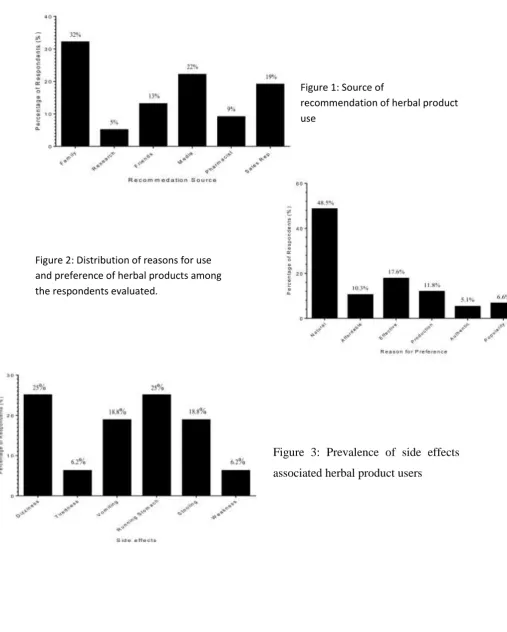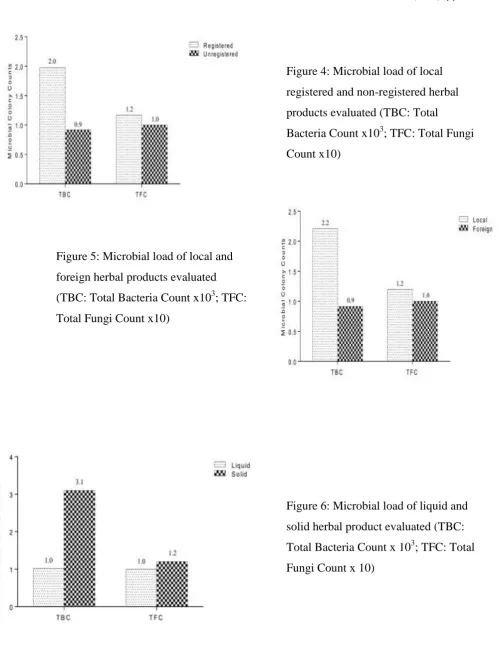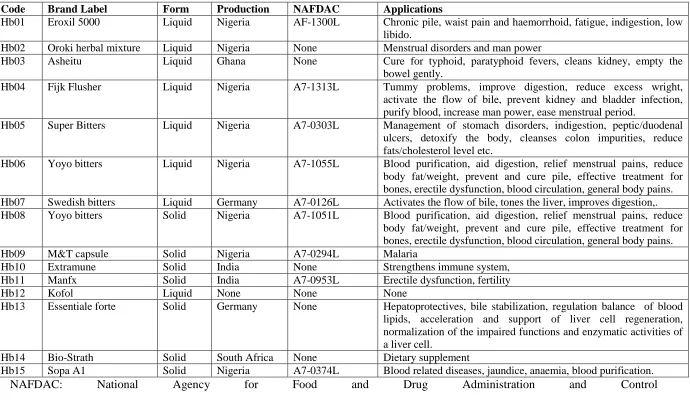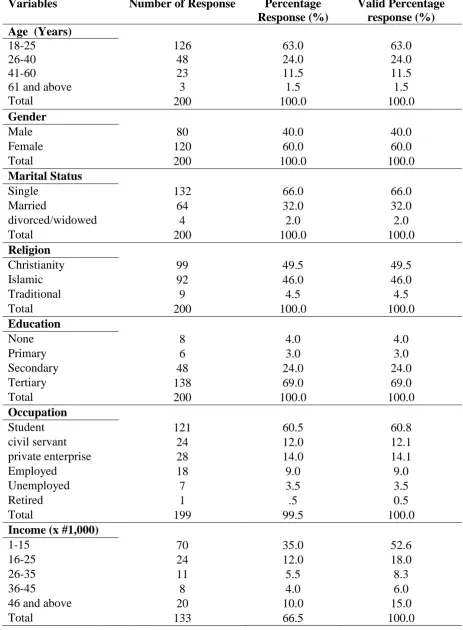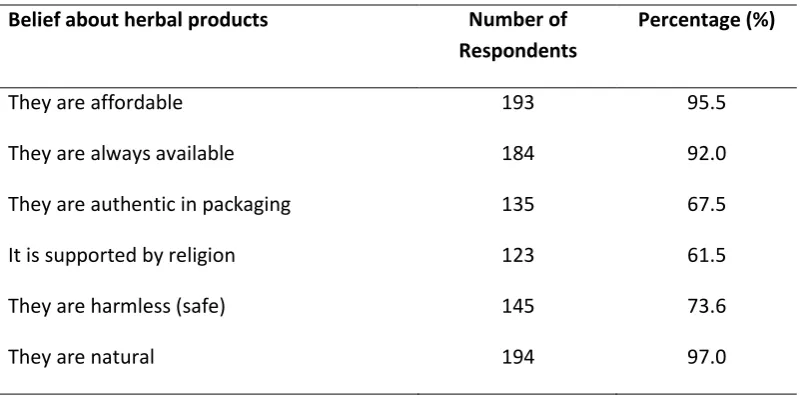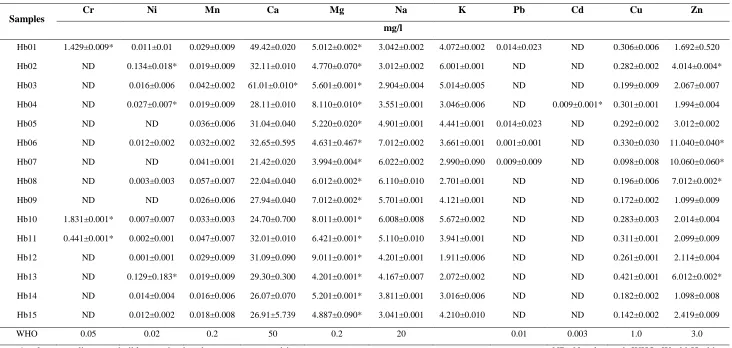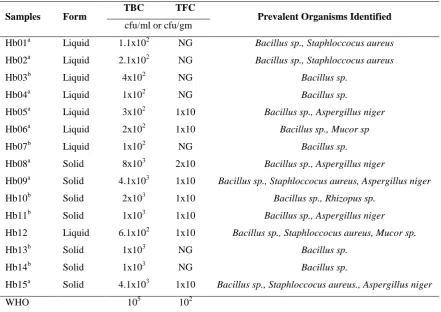*Corresponding author:Amusa O.D. (Ph.D.); Department of Cell Biology and Genetics, University of Lagos, Nigeria; Email: oluwafemiamusa@gmail.com , Phone: +2348065547710
40
herbmed.skums.ac.ir
An investigation of reasons for packaged herbal medicinal product use and safety in Lagos State, Nigeria.
*1
Amusa Oluwafemi Daniel, 2Eleyowo Oluwole Olusola.
1
Department of Cell Biology and Genetics, University of Lagos, Nigeria
2
Department of Science Laboratory Technology, Lagos State Polytechnic, Nigeria
Received: 05/ September/2018 Accepted: 20/ December/ 2018
ABSTRACT
Background and aims: Herbal medicine is of great importance to man and has been increasingly acceptable worldwide during the last decades as the main form of health care. With this increase, the safety of its products have become a major concern in public health. Hence, the study was aimed to elucidate the reasons for its increased patronage and ascertain the safety of the commonly preferred herbal medicinal product in Lagos State.
Methods: Questionnaires were administered to 200 herbal users randomly selected among the populace of Lagos State. Microbial load and heavy metal analysis were evaluated on 15 most preferred herbal medicinal products for safety evaluation. Results were then compared with WHO permissive limits.
Results: Natural nature (48.5%), effectiveness (17.6%) and affordability (10.3%) were cited as the major reason for the increased preference for herbal medicinal products. These were supported by family (32%) and media (22%) influences. Microbial load of the 15 most preferred herbal medicinal products evaluated were below WHO permissive level while some of them had cadmium, nickel and zinc beyond WHO permissive level. Baccillus sp. was observed to be the predominant bacteria (100%) while Aspergillus niger was the highest observed fungi (33.33%) among sampled products.
Conclusion: The study revealed that although, the herbal products evaluated in the study had low microbial loads, the presence of cadmium, nickel and zinc beyond permissible limits constitute a major toxic concern to the users.
Keywords: Herbal medicine, Heavy metals, Microbial load
O
ri
gi
na
l ar
ticl
Reason for herbal use and their safety
41
INTRODUCTION
Herbal medicine is of great importance to man and his health. It is perhaps the oldest method of coping with illnesses. Its use has been increasingly accepted worldwide during the last few decades often as the main source of healthcare in low- and middle-income countries (Sa‟ad et al., 2006; WHO, 2007). Herbal medicinal product (HMP) encompass a variety of self-prescribed preparations of plant origin that may generally be categorised as food, dietary supplements, cosmetics, and herbal medicinal products. The classification of herbal products is not aligned at either the European Union (EU) or global level, and remains under national competence (AESGP, 2009; WHO, 2005).
However, with their popularity, global market expansion and increased usage, the safety of HMPs has become a major concern in public health (WHO, 2007). They are not completely harmless despite their widespread use and reported benefits (Tracy and Kingston, 2007). There is a common belief by the public that these plants products are safer and more effective than prescription drugs, and that they have fewer adverse effects (Park et al., 2010). This has increased the inappropriate and non-regulated use of several HMPs which may put the health of the users at risk of toxicity and infection (Oreagba et al., 2011).
We observed recently that there has been an increased preference of package
HMPs to hawked or road side herbal products in the Lagos metropolis especially in public places, parks etc. even in the academia. This elicit our interest to evaluate reason(s) for this increase among herbal users and ascertain the safety of the most used HMPs among the sampled populace of Lagos State, Nigeria.
METHODS
Development of Questionnaire for
Survey
42 section C dealt with the respondent‟s attitude towards herbal products and section D dealt with the respondent‟s perception and beliefs about herbal products. The completed questionnaire was collected and analysed. Data was expressed in counts (responses) and percentages.
Herbal Product sample collection
Fifteen (15) packaged HMPs most
used according to sampled respondents
for oral administration were bought
from local markets in Lagos State,
Nigeria. Samples were both liquid and
solid, registered and non-registered,
local and foreign medication forms.
Samples were placed in the sterilized
plastic bags and stored accordingly until
needed. The sample labels, registration
numbers, form, production location and
their prescribed usage along with their
manufacturers are described in Table 1
below.
Heavy metals evaluation of herbal
products
100 ml/10 g of each of the herbal
product sample was measured into a
250 ml conical flask and about 2-3 g of
glass beads. 5ml of aqua redia
(HNO3:HCl, 1:3) was then added to the
content inside the flask and mixed
thoroughly. The flask, with the content
was later placed on a hot plate to heat
for some minutes to evaporate to about
15 ml. The flask was then cooled and
another 5ml of conc. HNO3 was added.
The flask was covered with watch glass.
Few ml of conc. HNO3 was added
dropwise on till the solution appears
light colour and clear. The flask and
watch glass were washed with distilled
water and the sample was filtered into
the Atomic Absorption Spectrometry
(AAS) ready for analysis. In the present
study, the analysed metals include lead,
cadmium, chromium, nickel, copper,
manganese, cobalt, iron and zinc. The
gases used for reading were acetylene
and compressed air in the flame
analysis with hollow cathode lamp, a
procedure performed in accordance with
Association of Analysis Communities
(AOAC) guidelines.
Preparation and sterilization of
media
Microbial evaluation was done
following the method of Eleyowo et al.
(2016). The following media which
include Nutrient Agar (NA), Salmonella
Shigella Agar (SSA), MacConkey agar
(MCA) and Potato Dextrose Agar
(PDA) were used for the enumeration of
Advanced Herbal Medicine, 2018; 4(4): 40-48
43 according to the manufacturer‟s guide
and sterilized in an autoclave at 121oC for 15 min.
Microbial analysis of herbal product
samples
Microbial analyses were carried out
in Microbiology Laboratory,
Department of Microbiology,
University of Lagos, Lagos State. The
pour plate method was used to cultivate
serially diluted portions of the herbal
product samples under investigation.
Enumeration was carried out on NA,
SSA, MCA and PDA for bacteria,
coliform and fungi counts. Triplicate
plates of appropriate dilutions were
prepared. The NA, SSA and MCA
plates were incubated at 37oC for 24 - 48 h for bacteria growth while PDA
plates were incubated at room
temperature (28 ± 2oC) for 48 - 72 h for fungal growth. The developed microbial
colonies were counted and computed as
colony forming units per millilitre or
gram (cfu/ml or cfu/g) of each sample
respectively. The colonies were isolated
and purified for further identified with
biochemical reactions which include
gram‟s staining, coagulase test, catalase
test and microscopy (Eleyowo et al.,
2016).
Statistical analysis
The data generated from evaluations
were analysed and expressed as mean
values of three replicates of the total
heterotrophic bacteria and fungi (cfu/ml
or cfu/gm) contained in each herbal
product sample screened. All analysis
was done using IBM SPSS Statistics
v.23 software package.
RESULTS
Socio-demographics of participants
44 Source of HMP recommendation
Percentage proportion of recommendation sources for sampled herbal users is shown in Figure 1. Recommendations from family on herbal product use was highest (32%) followed by media (22%). The least
recommendation came from
independent research (5%) followed by pharmacist recommendation (9%).
Evaluation of beliefs and reasons for HMP use
The responses and percentage belief of participants‟ view of herbal product represented in Table 3. The belief that herbal products are natural (97% believed) and a health promoter (96%) ranked highest among participants‟ beliefs. The least of the belief was religion inclined (61%), this was followed by packaging authenticity (67.5%).
Various reasons were also given by herbal users sampled for their increased patronage. The most reason for herbal products usage among the evaluated participants was that herbal products are natural products (48.5%), this was followed by herbal products‟ effectiveness (17.6%) while authenticity was the least reason of herbal product usage (5.1%) (Figure 2). The survey also showed that majority (81.9%) of the participant‟s preference local herbal products to foreign/imported herbal products (18.1%), with 72.5% of the sampled participants preferring liquid herbal products to the solid or capsule
form, while alcohol extract (6.5%) herbal products was least preferred.
Side effects from herbal product usage reported by participants
Majority (61.5%) of the participants revealed that their usage of herbal products was unknown to any health worker. Although, 84% of the participant evaluated revealed no side effects associated with herbal product usage, some participants reported dizziness (25%) and running stomach (25%) to be most prevalent side effects experienced from herbal product usage. This was followed by vomiting (18%) and stooling (18%) (Figure 3).
Evaluation of Heavy metal contents in herbal products sampled
Reason for herbal use and their safety
45 Figure 2: Distribution of reasons for use
and preference of herbal products among the respondents evaluated.
Figure 1: Source of
recommendation of herbal product use
Figure 3: Prevalence of side effects
46 contained high chromium contents (Table 4).
Comparative evaluation was done on heavy metal contents in HMP samples based on product‟s registration status, production location and product‟s forms in comparison with WHO permissible concentration (Table 5). The evaluation revealed that registered HMP samples contain higher contents of magnesium, cadmium and zinc than both unregistered HMP samples and WHO permissive concentrations. On the other hand, the unregistered brands of HMP samples evaluated contained higher nickel and magnesium contents than both the registered HMP samples and WHO permissive concentrations. In the study, both local and foreign HMP samples contained high nickel, magnesium and zinc contents while local HMPs contained high cadmium contents than WHO permissive concentrations. Also, both liquid and solid forms of HMP samples evaluated contained high nickel and magnesium contents. However, the liquid HMP samples contained high cadmium and zinc contents in addition
than the WHO permissive
concentrations (Table 5).
Evaluation of microbial load in herbal products sampled
Microbial evaluation of herbal products showed all HMPs had microbial load within WHO permissive limits. Total bacteria count ranged between 1x102-8x103 cfu while total fungi count ranged between 0-200 cfu. Hb04 and Hb07 contained the least Total bacteria count among evaluated
HMPs. No fungi growth was observed with Hb01, Hb02, Hb03, Hb04, Hb07, Hb13 and Hb14. The study also observed no growth in the SSA media
used for all HMP samples (Table 6). Prevalent microorganisms isolated include Bacillus sp. (100%),
Staphloccocus aureus (33.33%),
Aspergillus niger (33.33%), mucor sp. (6.67%) and Rhizopus sp. (6.67%) were predominat microbes identified in this product (Table 7). Evaluation of registered and non-registered herbal products showed that the registered HMP samples have more bacteria count (1.98 x 103cfu) and fungi count (1.17 x 10 cfu) more than the non-registered HMP samples (TBC = 0.92 x 103cfu, TFC = 1 x 102cfu) (Figure 4). The study also observed more bacteria and fungi colonies (TBC = 2.21 x103cfu, TFC = 1.2 x 10 cfu) in local HMP samples than the foreign HMP samples evaluated (TBC = 0.92 x103cfu, TFC = 1.0 x10 cfu) (Figure 5). On the other hand, the solid forms of HMPs sampled evaluated harboured more bacteria and fungi colonies (TBC = 3.10 x 103cfu, TFC = 1.2 x 10 cfu) than the liquid forms HMPs sampled in the study (TBC = 1.03 x 103cfu, TFC = 1.0 x 10 cfu) (Figure 6).
DISCUSSION
Advanced Herbal Medicine, 2018; 4(4): 40-48
47 Figure 5: Microbial load of local and
foreign herbal products evaluated
(TBC: Total Bacteria Count x103; TFC: Total Fungi Count x10)
Figure 4: Microbial load of local
registered and non-registered herbal
products evaluated (TBC: Total
Bacteria Count x103; TFC: Total Fungi Count x10)
Figure 6: Microbial load of liquid and
solid herbal product evaluated (TBC:
48 the main reasons for their use. This was supported by the belief that “natural product is safe and affordable” when compared to the unorthodox medicine. This corroborates with the work of Himesh et al. (2012) who stated that the demand for herbal products was due to the fact that it is natural and not likely to cause serious side effects compared to conventional drugs. These beliefs were shared by family members, as recommendation by family was observed to the highest influential means of increasing packaged herbal product preference as shown in this study. The media also played a key role in increasing the preference of packaged HMP use among sampled participants as many herbal companies today have taken the media advantage in reaching more customers than the conventional hawking methods. One additional factor that foster the use of packaged HMPs was its availability as reported by the respondents in this study. This coupled with affordability have been known to increase consumer product relationship.
Despite these, herbal users should not be ignorant of the possible contamination of these products by microorganisms especially bacteria and fungi as well as heavy metals contamination (Himesh et al., 2012). The study evaluated the safety of 15 most preferred packaged HMPs as stated by respondents in the metropolitan city of Lagos. Some of these products were registered and not registered, liquid or solid forms, majorly local but a few were foreign.
Advanced Herbal Medicine, 2018; 4(4): 40-48
49 contamination in random samples of HMPs purchased in Lagos State contrary to the results obtained in this study. This might be due to improvement in HMP preparation and production procedures from the herbal product companies.
The preference of local packaged HMPs by respondents against foreign HMPs is an indication of the respondents‟ trust on their native HMPs. The study showed that local packaged HMPs did not differ in safety level with packaged foreign HMPs. Although, both local and foreign packaged HMPs evaluated were having nickel, magnesium, and zinc contaminations more than WHO permissive limits, the presence of cadmium in local packaged HMPs more than permissive limit is an indication of the poor handling of local packaged HMPs when compared to foreign HMPs. Similarly, local packaged HMPs were observed to harbour more microbial load than their foreign counter parts.
The study showed that solid packaged HMPs contained more heavy metal contaminations than the liquid forms. Although most of the respondents preferred the liquid form of HMPs to the solid forms, this is of high concern. This preference might be due to the belief that the liquid forms are more effective than the solid forms although, there was no data to back this reason up. Nickel and magnesium were observed in both liquid and solid forms
higher than WHO permissive limits, cadmium and zinc beyond permissive limits were observed in the liquid forms which was lacking in the solid forms of packaged HMPs. The presence of these heavy metals above permissive limits may cause bioaccumulation of these toxic metals in regular consumers which may result in health complications issues. On the other hand, total bacteria and fungi counts were observed to higher in solid packaged herbal forms than the liquid packaged HMP forms but below permissive level. Bacillus sp. (100%), Staphloccocus aureus (33.33%), Aspergillus niger (33.33%), mucor sp (6.67%) and Rhizopus sp (6.67%) were predominant microbes identified in this study. Previous studies have shown high diversity of microbial contaminations in herbal products both registered and unregistered, liquid or solid forms (Oyetayo, 2008; Archibong et al., 2017).
50 significant level when compare to WHO permissive limit. The presence of Bacillus species may be as a result of inadequate heat processing, improper handling of products and contaminated processing equipment (Frazier and Westhoff, 2003). The presence of the fungal contaminant shows the possibility of poor storage conditions. This is a serious contaminant since some common species of fungi produce toxins like aflatoxins if allowed to build up in the product. According to the WHO, aflatoxins in herbal drugs can be dangerous to health even if they are absorbed in minute amounts (Ngari et al., 2013).
The contamination of herbal remedies with heavy metals may be due to soil and atmospheric contamination which poses a threat to its quality and safety. Medicinal plants used in HMPs preparation are normally contaminated with toxic metals during growth, development and processing (Nwoko and Mgbeahuruike, 2011). Some arise from past or present use of agents that pollute the environment and subsequently medicinal plants, such as factory emissions or persistent chemical residues. Due to their excessive use and disposal, contaminants from environmental sources may even be present where an herb is organically grown (WHO, 2007). Microbial contamination of herbs and/or products may result from improper handling during production and packaging. The most likely sources of contamination are microbes from the ground and processing facilities (contaminated air, microbes of human
origin). Cross contamination is also possible from extraneous materials such as plastics, glass, and other materials which come in contact with medicinal herbs, herbal preparations or products. Hypothetically, sources of biological contamination could be human excrement, animal manure and faeces used as fertilizers (Kosalec et al., 2009).
CONCLUSIONS
The natural nature and affordability coupled with the safety believe in the natural products of HMPs is shown to be the major factors determining the increase use of HMPs. This was largely influenced by family ties as revealed in this study. While most of the HMPs used by herbal users evaluated showed some certain level of safety as believed by users, the presence of some certain heavy metals beyond permissible limits calls for concern. More efforts need to be made by manufacturers to ensure product safety is not compromised at any level of production.
CONFLICT OF INTEREST
The authors declare that there is no
conflict of interest. The authors alone
are responsible for the content of the
paper
Authors’ Contributions
Advanced Herbal Medicine, 2018; 4(4): 40-48
51 Eleyowo, O.O. Project conception, Questionnaire development, Data collection and preparation, Interpretation of results, Manuscript preparation and review
ACKNOWLEDGEMENT
REFERENCES
Archibong EJ, Igboeli CN, Okoro NC,
Obika I. Microbiological
Assessment of Some Liquid Herbal
Medications Sold in Awka
Metropolis, Anambra State. Bioeng
Biosci. 2017; 5(3): 37-46
Association Européenne des Spécialités
Pharmaceutiques Grand Public
(AESGP). Economic and Legal
Framework for Non-Prescription
Medicines. 15th ed. Brussels:
AESGP; 2009.
Etuk EU, Igbokwe V, Ajagbonna OP,
Egua MO. (2008). Heavy metals
and microbial contaminants in
commercial polyherbal products in
Nigeria. Nig J Basic Appl Sci.
2008; 18(2): 197-202
Frazier WC, Westhoff DC. Food
microbiology. London: Mc-Graw
Hill publishing company Limited,
2003; 1200p.
Himesh S, Singhai AK, Jitender KM.
Heavy metals in herbal
preparations – A review. Int J Drug
Res Technol 2012; 2(6): 430-439
Idu M, Jimoh A, Ovuakporie-Uvo O.
Microbial load of some polyherbal
products from Lagos State, Nigeria.
Int J Ethnobiol Ethnomed. 2015;
1(1).1-14
Kosalec I, Cvek, J, Tomic S.
Contaminants of medicinal herbs
and herbal products. Herb Herbal
Prodt Contaminants. 2009; 60:
485-501
Ngari FW, Gikonyo NK, Wanjau RN,
Njagi NM. Investigation of
selected pathogenic
microorganisms and toxic elements
in herbal materials used in
management of oral health in
Nairobi country, Kenya. J Appl
Environ Biol Sci. 2013; 3(12): 1-7
Nwoko OC, Mgbeahuruike, L. Heavy
Metal Contamination of
Ready-to-use Herbal Remedies in South
Eastern Nigeria. Pak J Nutr. 2011;
10 (10): 959- 964
Oreagba IA, Oshikoya KA, Amachree
M. Herbal medicine use among
52 residents in Lagos, Nigeria. BMC
Compl Alt Med. 2011; 11(1):
117-125
Oyetayo VO. Microbial load and
antimicrobial property of Two
Nigerian herbal remedies. African J
Trad Compl Alt Med. 2008; 5(1):
74-78
Park JJ, Kang M, Shin S, Choi E, Kwon
S, Wee H, Nam B, Kaptchuk T J.
Unexplained infertility treated with
acupuncture and herbal medicine in
Korea. J Alt Compl Med. 2010;
16(2): 193-198
Sa‟ad B, Hassan A, Ghassam A, Omar
S. Safety of Traditional Arab
Herbal Medicine. Oxford J Med
Evidence based Comp and Aff Med.
2006;3(4): 433-439
Tracy TS, Kingston RL. Herbal
products-toxicity and clinical
pharmacology. 2nd Edn. Humana Press Inc. USA, 2007; 300pp
WHO (2005) World Health
Organization: National policy on
traditional medicine and regulation
of herbal medicines report of a
WHO global survey. Geneva.
WHO (2007) World Health
Organization: WHO guidelines for
assessing quality of herbal
medicines with reference to
Advanced Herbal Medicine, 2018; 4(4): 40-48
53 Table 1: List of Herbal products evaluated
Code Brand Label Form Production NAFDAC Applications
Hb01 Eroxil 5000 Liquid Nigeria AF-1300L Chronic pile, waist pain and haemorrhoid, fatigue, indigestion, low libido.
Hb02 Oroki herbal mixture Liquid Nigeria None Menstrual disorders and man power
Hb03 Asheitu Liquid Ghana None Cure for typhoid, paratyphoid fevers, cleans kidney, empty the bowel gently.
Hb04 Fijk Flusher Liquid Nigeria A7-1313L Tummy problems, improve digestion, reduce excess wright, activate the flow of bile, prevent kidney and bladder infection, purify blood, increase man power, ease menstrual period.
Hb05 Super Bitters Liquid Nigeria A7-0303L Management of stomach disorders, indigestion, peptic/duodenal ulcers, detoxify the body, cleanses colon impurities, reduce fats/cholesterol level etc.
Hb06 Yoyo bitters Liquid Nigeria A7-1055L Blood purification, aid digestion, relief menstrual pains, reduce body fat/weight, prevent and cure pile, effective treatment for bones, erectile dysfunction, blood circulation, general body pains. Hb07 Swedish bitters Liquid Germany A7-0126L Activates the flow of bile, tones the liver, improves digestion,. Hb08 Yoyo bitters Solid Nigeria A7-1051L Blood purification, aid digestion, relief menstrual pains, reduce
body fat/weight, prevent and cure pile, effective treatment for bones, erectile dysfunction, blood circulation, general body pains.
Hb09 M&T capsule Solid Nigeria A7-0294L Malaria
Hb10 Extramune Solid India None Strengthens immune system,
Hb11 Manfx Solid India A7-0953L Erectile dysfunction, fertility
Hb12 Kofol Liquid None None None
Hb13 Essentiale forte Solid Germany None Hepatoprotectives, bile stabilization, regulation balance of blood lipids, acceleration and support of liver cell regeneration, normalization of the impaired functions and enzymatic activities of a liver cell.
Hb14 Bio-Strath Solid South Africa None Dietary supplement
Hb15 Sopa A1 Solid Nigeria A7-0374L Blood related diseases, jaundice, anaemia, blood purification.
54
Table 2: Characteristics distribution of respondents‟ socio-demography
Variables Number of Response Percentage
Response (%)
Valid Percentage response (%) Age (Years)
18-25 126 63.0 63.0
26-40 48 24.0 24.0
41-60 23 11.5 11.5
61 and above 3 1.5 1.5
Total 200 100.0 100.0
Gender
Male 80 40.0 40.0
Female 120 60.0 60.0
Total 200 100.0 100.0
Marital Status
Single 132 66.0 66.0
Married 64 32.0 32.0
divorced/widowed 4 2.0 2.0
Total 200 100.0 100.0
Religion
Christianity 99 49.5 49.5
Islamic 92 46.0 46.0
Traditional 9 4.5 4.5
Total 200 100.0 100.0
Education
None 8 4.0 4.0
Primary 6 3.0 3.0
Secondary 48 24.0 24.0
Tertiary 138 69.0 69.0
Total 200 100.0 100.0
Occupation
Student 121 60.5 60.8
civil servant 24 12.0 12.1
private enterprise 28 14.0 14.1
Employed 18 9.0 9.0
Unemployed 7 3.5 3.5
Retired 1 .5 0.5
Total 199 99.5 100.0
Income (x #1,000)
1-15 70 35.0 52.6
16-25 24 12.0 18.0
26-35 11 5.5 8.3
36-45 8 4.0 6.0
46 and above 20 10.0 15.0
Advanced Herbal Medicine, 2018; 4(4): 40-48
55 Table 3: Perception and Beliefs of herbal users evaluated
Belief about herbal products Number of
Respondents
Percentage (%)
They are affordable 193 95.5
They are always available 184 92.0
They are authentic in packaging 135 67.5
It is supported by religion 123 61.5
They are harmless (safe) 145 73.6
56 Table 4: Heavy metal prevalence in herbal product samples evaluated
Samples Cr Ni Mn Ca Mg Na K Pb Cd Cu Zn
mg/l
Hb01 1.429±0.009* 0.011±0.01 0.029±0.009 49.42±0.020 5.012±0.002* 3.042±0.002 4.072±0.002 0.014±0.023 ND 0.306±0.006 1.692±0.520
Hb02 ND 0.134±0.018* 0.019±0.009 32.11±0.010 4.770±0.070* 3.012±0.002 6.001±0.001 ND ND 0.282±0.002 4.014±0.004*
Hb03 ND 0.016±0.006 0.042±0.002 61.01±0.010* 5.601±0.001* 2.904±0.004 5.014±0.005 ND ND 0.199±0.009 2.067±0.007
Hb04 ND 0.027±0.007* 0.019±0.009 28.11±0.010 8.110±0.010* 3.551±0.001 3.046±0.006 ND 0.009±0.001* 0.301±0.001 1.994±0.004
Hb05 ND ND 0.036±0.006 31.04±0.040 5.220±0.020* 4.901±0.001 4.441±0.001 0.014±0.023 ND 0.292±0.002 3.012±0.002
Hb06 ND 0.012±0.002 0.032±0.002 32.65±0.595 4.631±0.467* 7.012±0.002 3.661±0.001 0.001±0.001 ND 0.330±0.030 11.040±0.040*
Hb07 ND ND 0.041±0.001 21.42±0.020 3.994±0.004* 6.022±0.002 2.990±0.090 0.009±0.009 ND 0.098±0.008 10.060±0.060*
Hb08 ND 0.003±0.003 0.057±0.007 22.04±0.040 6.012±0.002* 6.110±0.010 2.701±0.001 ND ND 0.196±0.006 7.012±0.002*
Hb09 ND ND 0.026±0.006 27.94±0.040 7.012±0.002* 5.701±0.001 4.121±0.001 ND ND 0.172±0.002 1.099±0.009
Hb10 1.831±0.001* 0.007±0.007 0.033±0.003 24.70±0.700 8.011±0.001* 6.008±0.008 5.672±0.002 ND ND 0.283±0.003 2.014±0.004
Hb11 0.441±0.001* 0.002±0.001 0.047±0.007 32.01±0.010 6.421±0.001* 5.110±0.010 3.941±0.001 ND ND 0.311±0.001 2.099±0.009
Hb12 ND 0.001±0.001 0.029±0.009 31.09±0.090 9.011±0.001* 4.201±0.001 1.911±0.006 ND ND 0.261±0.001 2.114±0.004
Hb13 ND 0.129±0.183* 0.019±0.009 29.30±0.300 4.201±0.001* 4.167±0.007 2.072±0.002 ND ND 0.421±0.001 6.012±0.002*
Hb14 ND 0.014±0.004 0.016±0.006 26.07±0.070 5.201±0.001* 3.811±0.001 3.016±0.006 ND ND 0.182±0.002 1.098±0.008
Hb15 ND 0.012±0.002 0.018±0.008 26.91±5.739 4.887±0.090* 3.041±0.001 4.210±0.010 ND ND 0.142±0.002 2.419±0.009
WHO 0.05 0.02 0.2 50 0.2 20 0.01 0.003 1.0 3.0
Advanced Herbal Medicine, 2018; 4(4): 40-48
57
Table 5: Heavy metal prevalence in herbal product samples based on registration status, production location and form
Group
Cr Ni Mn Ca Mg Na K Pb Cd Cu Zn
mg/l
Product Status
Registered (n = 9) ND 0.011±0.009 0.034±0.014 30.171±8.078 5.700±1.258* 4.943±1.383 3.687±0.600 0.010±0.015 0.009±0.009* 0.239±0.084 4.492±3.693*
Unregistered (n = 6) ND 0.060±0.114* 0.026±0.012 34.638±13.910 5.557±1.358* 3.981±1.159 4.355±1.596 ND ND 0.273±0.088 3.041±1.826
Product Type
Local (n = 8) ND 0.033±0.077* 0.030±0.014 31.278±7.909 5.707±1.206* 4.546±1.526 4.032±0.953 0.010±0.017 0.009±0.009* 0.253±0.0.069 4.035±3.231*
Foreign (n = 6) ND 0.034±0.085* 0.033±0.013 32.418±13.603 5.572±1.404* 4.670±1.182 3.784±1.278 0.009±0.009 ND 0.249±0.107 3.892±3.265*
Product Form
Liquid (n = 8) ND 0.034±0.077* 0.031±0.010 35.857±12.712 5.794±1.712* 4.331±1.464 3.892±1.227 0.010±0.015 0.009±0.009* 0.259±0.073 4.499±3.649*
Solid (n = 7) ND 0.028±0.078* 0.031±0.016 26.995±3.558 5.964±1.246* 4.850±1.132 3.676±1.129 ND ND 0.244±0.094 3.108±2.273
WHO 0.050 0.020 0.200 50.000 0.200 NA NA 0.010 0.003 1.000 3.000
58
Table 6: Microbial load evaluation from herbal products sampled
Samples Form TBC TFC Prevalent Organisms Identified
cfu/ml or cfu/gm
Hb01a Liquid 1.1x102 NG Bacillus sp., Staphloccocus aureus
Hb02a Liquid 2.1x102 NG Bacillus sp., Staphloccocus aureus
Hb03b Liquid 4x102 NG Bacillus sp.
Hb04a Liquid 1x102 NG Bacillus sp.
Hb05a Liquid 3x102 1x10 Bacillus sp., Aspergillus niger
Hb06a Liquid 2x102 1x10 Bacillus sp., Mucor sp
Hb07b Liquid 1x102 NG Bacillus sp.
Hb08a Solid 8x103 2x10 Bacillus sp., Aspergillus niger
Hb09a Solid 4.1x103 1x10 Bacillus sp., Staphloccocus aureus, Aspergillus niger
Hb10b Solid 2x103 1x10 Bacillus sp., Rhizopus sp.
Hb11b Solid 1x103 1x10 Bacillus sp., Aspergillus niger
Hb12 Liquid 6.1x102 1x10 Bacillus sp., Staphloccocus aureus, Mucor sp.
Hb13b Solid 1x103 NG Bacillus sp.
Hb14b Solid 1x103 NG Bacillus sp.
Hb15a Solid 4.1x103 1x10 Bacillus sp., Staphloccocus aureus., Aspergillus niger
WHO 105 102
a and b superscript denote local and foreign herbal products; * value exceeding maximum permitted; NG: No growth; cfu/ml: colony forming unit per millilitre; cfu/gm: colony forming unit per gram; TBC: Total Bacteria Count; TFC: Total Fungi Count; WHO: World Health Organization maximum colony count permitted.
Table 7. Frequency occurrence of isolated microorganisms
Microbial Isolates Frequency Occurrence (%)
Bacillus sp. 15 100
Staphloccocus aureus 5 33.33
Aspergillus niger 5 33.33
Mucor sp. 1 6.67
